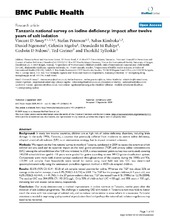Tanzania national survey on iodine deficiency: impact after twelve years of salt iodation
Assey, Vincent Didas; Peterson, Stefan; Kimboka, Sabas; Ngemera, Daniel; Mgoba, Celestin; Ruhiye, Deusdedit M.; Ndossi, Godwin D.; Greiner, Ted; Tylleskär, Thorkild
Peer reviewed, Journal article
Published version

Permanent lenke
https://hdl.handle.net/1956/3720Utgivelsesdato
2009-09-03Metadata
Vis full innførselSamlinger
Originalversjon
https://doi.org/10.1186/1471-2458-9-319Sammendrag
Background: In many low-income countries, children are at high risk of iodine deficiency disorders, including brain damage. In the early 1990s, Tanzania, a country that previously suffered from moderate to severe iodine deficiency, adopted universal salt iodation (USI) as an intervention strategy, but its impact remained unknown. Methods: We report on the first national survey in mainland Tanzania, conducted in 2004 to assess the extent to which iodated salt was used and its apparent impact on the total goitre prevalence (TGP) and urinary iodine concentrations (UIC) among the schoolchildren after USI was initiated. In 2004, a cross-sectional goitre survey was conducted; covering 140,758 schoolchildren aged 6 - 18 years were graded for goitre according to new WHO goitre classification system. Comparisons were made with district surveys conducted throughout most of the country during the 1980s and 90s. 131,941 salt samples from households were tested for iodine using rapid field test kits. UIC was determined spectrophotometrically using the ammonium persulfate digestion method in 4523 sub-sampled children. Results: 83.6% (95% CI: 83.4 - 83.8) of salt samples tested positive for iodine. Whereas the TGP was about 25% on average in the earlier surveys, it was 6.9% (95%CI: 6.8-7.0) in 2004. The TGP for the younger children, 6-9 years old, was 4.2% (95%CI: 4.0-4.4), n = 41,965. In the 27 goitre-endemic districts, TGP decreased from 61% (1980s) to 12.3% (2004). The median UIC was 204 (95% CF: 192-215) μg/L. Only 25% of children had UIC <100 μg/L and 35% were ≥ 300 μg/L, indicating low and excess iodine intake, respectively. Conclusion: Our study demonstrates a marked improvement in iodine nutrition in Tanzania, twelve years after the initiation of salt iodation programme. The challenge in sustaining IDD elimination in Tanzania is now two-fold: to better reach the areas with low coverage of iodated salt, and to reduce iodine intake in areas where it is excessive. Particular attention is needed in improving quality control at production level and perhaps the national salt iodation regulations may need to be reviewed.
